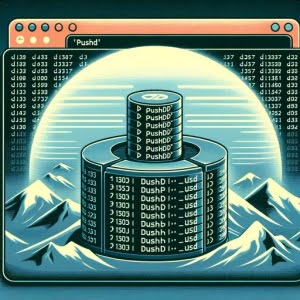Linux ‘pushd’ Command Guide for Easy Navigation

Ever felt like you’re lost in the maze of directories in your Linux terminal? You’re not alone. Many users find directory navigation in Linux a bit daunting. But there’s a tool that can make this process a breeze. Think of the ‘pushd’ command as a GPS for your Linux terminal – a powerful tool that enables you to navigate and manipulate directories with ease.
This guide will walk you through the pushd command in Linux, from its basic usage to more advanced techniques. We’ll cover everything from changing the current directory and saving the previous one, to using it with other directory stack commands, and even troubleshooting common issues.
So, let’s dive in and start mastering the pushd command in Linux!
TL;DR: What is the Pushd Command in Linux?
The
pushdcommand in Linux is a powerful tool that allows you to change the current directory and save the previous directory on a stack. This way, you can easily return to it whenever needed. You can use the command with the syntax,pushd /target/directory. It’s like having a bookmark for your directories in the Linux terminal.
Here’s a simple example:
pushd /home/user/documents
# Output:
# /home/user/documents ~
In this example, we use the pushd command to change the current directory to ‘/home/user/documents’. The tilde (~) represents the previous directory, which is saved on the stack. Now, if you want to go back to the previous directory, you can do so easily.
This is just a basic usage of the pushd command in Linux. There’s much more to learn about this command, including more advanced usage scenarios and tips. Continue reading for a more comprehensive guide.
Table of Contents
The pushd command in Linux is a powerful tool for directory navigation. It not only allows you to change your current directory but also saves the previous directory on a stack. This way, you can easily return to it whenever needed. It’s like having a bookmark for your directories in the Linux terminal.
Let’s take a look at a simple example to understand how it works:
pushd /home/user/documents/reports
# Output:
# /home/user/documents/reports ~
In this example, we use the pushd command to change the current directory to ‘/home/user/documents/reports’. The tilde (~) represents the previous directory, which is saved on the stack. Now, if you want to go back to the previous directory, you can do so easily.
Advantages of Using Pushd
One of the main advantages of using the pushd command is its ability to save your directory navigation history. This can be particularly useful when working with multiple directories and you need to switch back and forth between them.
Potential Pitfalls of Using Pushd
While the pushd command is extremely useful, it’s important to remember that the directory stack is not permanent. It resets every time you close the terminal. Therefore, if you’re relying on the stack to remember your directory navigation history, make sure to keep the terminal session open.
Advanced Usage of Pushd Command in Linux
As your comfort level with the pushd command grows, you’ll discover its true power lies in its advanced features. The pushd command’s flexibility allows it to handle more complex directory navigation tasks, such as using it with other directory stack commands like popd and dirs. Let’s explore some of these advanced uses.
Before we dive into the advanced usage of pushd, let’s familiarize ourselves with some of the command-line arguments or flags that can modify the behavior of the pushd command. Here’s a table with some of the most commonly used pushd arguments.
| Argument | Description | Example |
|---|---|---|
+n | Removes the nth directory (counting from the left of the list printed by dirs, starting with zero). | pushd +1 |
-n | Suppresses the normal change of directory when adding directories to the stack, so that only the stack is manipulated. | pushd -n /home/user/documents |
~ | Changes to the home directory. | pushd ~ |
- | Rotates the stack, making the current directory the new top of the stack. | pushd - |
dir | Makes ‘dir’ the current directory and pushes the old current directory onto the stack. | pushd /home/user/documents |
Now that we have a basic understanding of pushd command line arguments, let’s dive deeper into the advanced use of pushd.
Using Pushd with Popd and Dirs
The pushd command can be used in conjunction with popd and dirs commands to manipulate the directory stack more efficiently.
Here’s an example:
pushd /home/user/documents
pushd /home/user/downloads
# Output:
# /home/user/downloads /home/user/documents ~
popd
# Output:
# /home/user/documents ~
In this example, we first navigate to the ‘documents’ directory using the pushd command. Then, we navigate to the ‘downloads’ directory. The popd command is then used to remove the top directory from the stack, bringing us back to the ‘documents’ directory.
Using Pushd to Return to the Previous Directory
The pushd command can also be used to quickly return to the previous directory. Here’s how:
pushd .
pushd /home/user/downloads
pushd -
# Output:
# /home/user/documents /home/user/downloads
In this example, we first save the current directory by typing ‘pushd .’. We then navigate to the ‘downloads’ directory. Finally, we use ‘pushd -‘ to go back to the previous directory.
Using Pushd to Navigate to the Home Directory
The pushd command can also be used to quickly navigate to the home directory. Here’s an example:
pushd ~
# Output:
# ~ /home/user/documents
In this example, we use ‘pushd ~’ to navigate to the home directory.
These are just a few examples of the advanced usage of the pushd command in Linux. By understanding these techniques, you can make directory navigation in Linux a breeze.
Exploring Alternatives to Pushd Command in Linux
While the pushd command is a powerful tool for directory navigation in Linux, it’s not the only one. There are other commands and functions that can accomplish the same task as pushd. Let’s explore some of these alternatives, their benefits, drawbacks, and when to use them.
Navigating Directories with cd
The cd (change directory) command is the most basic command for directory navigation in Linux. It’s simple and straightforward to use. However, unlike pushd, the cd command doesn’t save the previous directory on a stack. This means you can’t easily return to the previous directory.
Here’s an example of using the cd command:
cd /home/user/documents
# Output:
# No output is expected
In this example, we use the cd command to change the current directory to ‘/home/user/documents’.
Using the Directory Stack with dirs
The dirs command in Linux displays the list of currently remembered directories. This can be a handy command when used in conjunction with pushd and popd. However, on its own, it doesn’t change the current directory.
Here’s an example of using the dirs command:
pushd /home/user/documents
pushd /home/user/downloads
dirs
# Output:
# /home/user/downloads /home/user/documents ~
In this example, we first navigate to the ‘documents’ directory and then to the ‘downloads’ directory using the pushd command. We then use the dirs command to display the list of remembered directories.
Returning to the Previous Directory with cd –
The ‘cd -‘ command in Linux allows you to quickly return to the previous directory. This command is an excellent alternative to ‘pushd -‘, especially when you need to switch back and forth between two directories.
Here’s an example of using the ‘cd -‘ command:
cd /home/user/documents
cd /home/user/downloads
cd -
# Output:
# /home/user/documents
In this example, we first navigate to the ‘documents’ directory and then to the ‘downloads’ directory using the cd command. We then use ‘cd -‘ to return to the previous directory.
These are just a few examples of the alternative approaches to the pushd command in Linux. Depending on your specific needs and the complexity of your directory navigation tasks, you might find one approach more suitable than the others.
Troubleshooting Common Pushd Command Issues
Like any other command, using the pushd command in Linux can sometimes lead to errors or unexpected results. Let’s discuss some of the common issues that you might encounter while using the pushd command and how to solve them.
Error: bash: pushd: no other directory
One of the most common errors you might encounter when using the pushd command is bash: pushd: no other directory. This error occurs when you try to use the pushd command without any arguments and there’s no other directory in the stack.
Here’s an example:
pushd
# Output:
# bash: pushd: no other directory
In this example, we try to use the pushd command without any arguments. Since there’s no other directory in the stack, the command returns an error.
To solve this issue, you can either specify a directory as an argument when using the pushd command or use the pushd command after navigating to a different directory using the cd command.
Using Pushd in Scripts
When using the pushd command in scripts, it’s important to remember that the directory stack is local to the shell. This means that if you use the pushd command in a script, the changes to the directory stack won’t affect the parent shell.
Here’s an example of using the pushd command in a script:
#!/bin/bash
cd /home/user/documents
pushd /home/user/downloads
# Output:
# /home/user/downloads /home/user/documents
In this example, we navigate to the ‘documents’ directory and then to the ‘downloads’ directory using the pushd command. However, these changes won’t affect the parent shell.
Best Practices and Optimization
When using the pushd command, it’s best to follow certain best practices for optimal results. Here are some tips:
- Always specify a directory as an argument when using the pushd command for the first time in a session. This will prevent the
bash: pushd: no other directoryerror. - Use the pushd command in conjunction with other directory stack commands like popd and dirs for efficient directory navigation.
- Remember that the directory stack is not permanent and resets every time you close the terminal. If you’re relying on the stack to remember your directory navigation history, make sure to keep the terminal session open.
Understanding the Directory Stack in Linux
To fully appreciate the power of the pushd command in Linux, it’s crucial to understand the concept of the directory stack. The directory stack is a list of directories that the shell keeps track of, allowing you to navigate between directories easily. It’s like a stack of plates – you can only add or remove a plate from the top of the stack.
When you use the pushd command, the shell ‘pushes’ the current directory onto the stack and then changes to the new directory. The previous directories remain on the stack, allowing you to ‘pop’ back to them when needed.
Let’s illustrate this with an example:
cd /home/user/documents
pushd /home/user/downloads
# Output:
# /home/user/downloads /home/user/documents
In this example, we first navigate to the ‘documents’ directory using the cd command. We then use the pushd command to navigate to the ‘downloads’ directory. The ‘documents’ directory is pushed onto the stack, allowing us to return to it easily.
Interactions Between Pushd and the Directory Stack
The pushd command interacts with the directory stack in a couple of ways. First, it adds the current directory to the top of the stack before changing to the new directory. Second, it allows you to manipulate the stack directly using command-line arguments. For example, you can remove directories from the stack or rotate the order of directories on the stack.
Related Commands and Broader Concepts
The pushd command is just one of several commands in Linux that interact with the directory stack. Other related commands include popd, which removes the top directory from the stack and changes to it, and dirs, which displays the current directory stack. Understanding these commands and how they interact with the directory stack can greatly enhance your efficiency when navigating directories in Linux.
Relevance of Pushd in Scripting
The pushd command is not just a tool for directory navigation. It can also be a powerful asset in larger scripts and projects. By leveraging the capabilities of pushd, you can streamline your workflow and increase your productivity.
Implementing Pushd in Large Scripts
In large scripts, directory navigation can become complex. The pushd command can be used to keep track of directories, allowing you to return to previous directories easily. Here’s an example:
#!/bin/bash
pushd /home/user/documents
# Perform some operations
pushd /home/user/downloads
# Perform some operations
popd
# You are now back in /home/user/documents
In this script, we first navigate to the ‘documents’ directory. After performing some operations, we navigate to the ‘downloads’ directory. Finally, we use the popd command to return to the ‘documents’ directory.
Complementary Commands to Pushd
There are several commands and functions that often accompany the pushd command. These include the popd command, which removes directories from the stack, and the dirs command, which displays the current directory stack. By using these commands together, you can create a powerful directory navigation system.
Further Resources for Mastering Pushd
To deepen your understanding of the pushd command and related topics, the following resources are highly recommended:
- GNU Bash Reference Manual: This is the official reference guide for Bash, the shell in which the pushd command is used. It provides in-depth information about all Bash commands.
The Linux Command Line: This website is a comprehensive guide to the Linux command line, including detailed tutorials on various commands, including pushd.
Linuxize: Linuxize provides a range of tutorials and guides on Linux commands and shell scripting. It’s a great resource for learning more about the pushd command and its applications.
Wrapping up: Pushd Command Guide
In this comprehensive guide, we’ve delved deep into the world of the pushd command in Linux, a robust tool for efficient directory navigation and manipulation.
We started off with the basics, learning how to use pushd to change the current directory and save the previous one on a stack. We then ventured into more advanced territory, exploring how pushd can be used with other directory stack commands like popd and dirs for a more efficient directory navigation experience.
We also tackled common issues that you might encounter when using the pushd command, such as the bash: pushd: no other directory error, and provided solutions to help you overcome these challenges. Alongside, we explored alternative approaches to the pushd command, comparing it with other directory navigation commands like cd and dirs.
Here’s a quick comparison of these commands:
| Command | Advantages | Disadvantages |
|---|---|---|
| pushd | Saves directory history, allows easy return to previous directories | Directory stack resets when terminal is closed |
| cd | Simple and easy to use | Doesn’t save directory history |
| dirs | Displays directory stack | Doesn’t change current directory |
Whether you’re just starting out with the pushd command or looking to level up your Linux directory navigation skills, we hope this guide has given you a deeper understanding of the pushd command and its capabilities.
With its ability to save directory navigation history and work with other directory stack commands, the pushd command is a powerful tool in any Linux user’s arsenal. Happy navigating!


